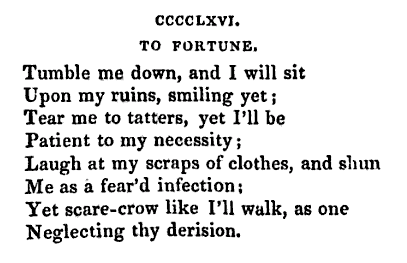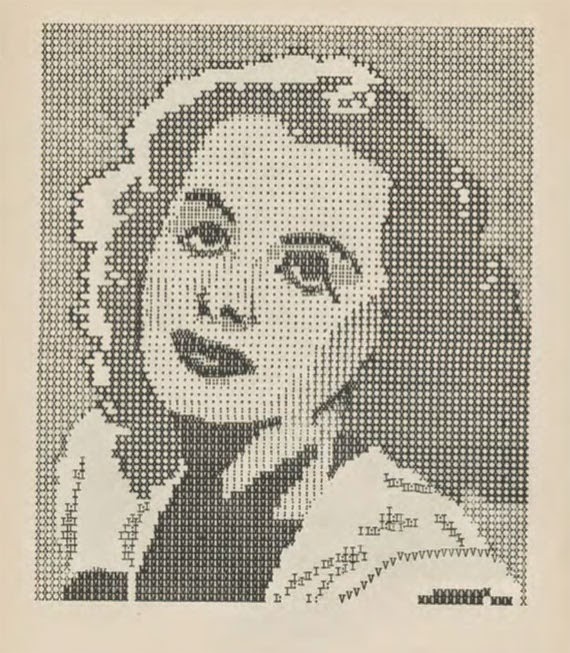
I hate to be a party pooper — no, really: I hate it — but I just don’t think Levi Stahl has found an emoticon in a seventeenth-century poem — nor, for that matter, that Jennifer 8. Lee found one from 1862.
About Stahl and Robert Herrick. If we were really serious about finding out whether Robert Herrick had used an emoticon, we’d look for his manuscripts — since we could never be sure that his printers had carried out his wishes accurately, especially in those days of highly variable printing practices. But those manuscripts, I think, are not available.
The next step would be to look online for a facsimile of the first, or at least a very early, edition, and while Google Books has just such a thing, it is not searchable. So, being the lazy guy that I am, I looked for nineteenth-century editions, and in the one I came across, there are no parentheses and hence no emoticon:
So it’s possible, I’d say likely, that the parenthesis in the poem was inserted by a modern editor. Not that parentheses weren’t used in verse in Herrick’s time — they were — but not as widely as we use them today and not in the same situations. Punctuation in general was unsettled in the seventeenth century — as unsettled as spelling: Shakespeare spelled his own name several different ways — and there were no generally accepted rules. Herrick was unlikely to have had consistent punctuational practices himself, and even if he did he couldn’t expect either his printers or his readers to share them.
So more generally, I think Stahl’s guess is ahistorical. The first emoticons seem to have been invented about thirty years ago, and are clearly the artifact of the computer age, or, more specifically, a purely digital or screen-based typewriting-only environment — because if you were printing something out before sending it, you could just grab a pen and draw a perfectly legible, friendly, not-rotated-90-degrees smiley, or frowney, or whatever, as people still do. Emoticons arose to address a problem that did not and does not exist in a paper-centric world.
And one final note: in the age between the invention of the typewriter and the transition to digital text, people certainly realized that type could make images — but they were rather more ambitious about it.




You're right, of course, that early modern typography can in no way be taken as any expression of authorial intention. I agree that this isn't an emoticon, mostly because of the word "smiling." There's just no need for an emoticon after that word. Emoticons tend to be used in situations where the emotion that they express needs more emphasis–e.g., after a joke that really needs to be read as a joke but might not be. Herrick is a poet who trusted each and every one of his words–and he was right to do that, because he used relatively few of them. He just said "smiling"; does he need to paint you a picture? He didn't need typographical gimmicks to make his point.
Now, maybe the compositor who set this line in the 1648 edition saw the opportunity and put in a colon and parenthesis to form a smiley. In my book, that would count as an emoticon. But that would have meant inserting the opening parenthesis, too–a bother–and it just doesn't seem that seventeenth century authors, printers, or readers paid enough attention to punctuation to make this conjunction of typographical characters anything more than a (happy!) coincidence.
I'm with you in doubting that Herrick or his earliest publishers included a smiley face in "To Fortune," but I should note that a 1648 printing of his works (from a copy at the Huntington Library) does indeed feature a colon beside an end parenthesis in this early version of "To Fortune." On the other hand, that collocation also appears on the very next page, in "To Anthea," as well as on the preceding page in a poem called "To M. Denham, on his Prospective Poem." A JPEG of "To Fortune" and "To Anthea", along with bibliographical information can be found for a week or so at http://ow.ly/vN9oO
A quick search through Early English Books Online (EEBO) turns up a colon and a parenthesis at the end of line 2 in the 1648 edition of Hesperides. It is therefore not a modern editorial intervention, and Henry G. Clarke's edition of 1844 (pictured above) departs from the first published edition of Herrick's poem. (I'm not sure about the status of Herrick's manuscripts.) I share your historicist's skepticism about understanding this case as the first instance of the smiley emoticon, though it is certainly interesting how typography can open up interpretive possibilities through time and editorial practice!
There's another poem in the same Herrick volume, "To his Faithfull Friend, Master John Crofts, Cup-Bearer to the King," that seems to have the same typographical construction [ link ] So, assuming that reflects the original, I think we're just looking at an idiosyncratic typographical usage (colon within parentheses) that is unusual to us, but that isn't an emoticon.
http://www.mhpbooks.com/late-breaking-news-nabokov-never-heard-of-the-parenthesis/
Good investigative thinking. I think you're almost certainly right about the 17th-century (non)emoticon, but there is evidence that emoticons were around long before any form of computer-generated typesetting existed. I wrote a column on this in MacUser magazine a couple of years ago, and I mentioned the Victorian-era Puck magazine's presentation of smiley-like faces. They weren't on their side – the type setters must have had fun with the hot metal arrangement – but they were in every other respect what we know today. I have many of my old columns online, so you can see this one if you're interested: http://www.thisbloglife.com/2012/07/ascii-and-emoticons/